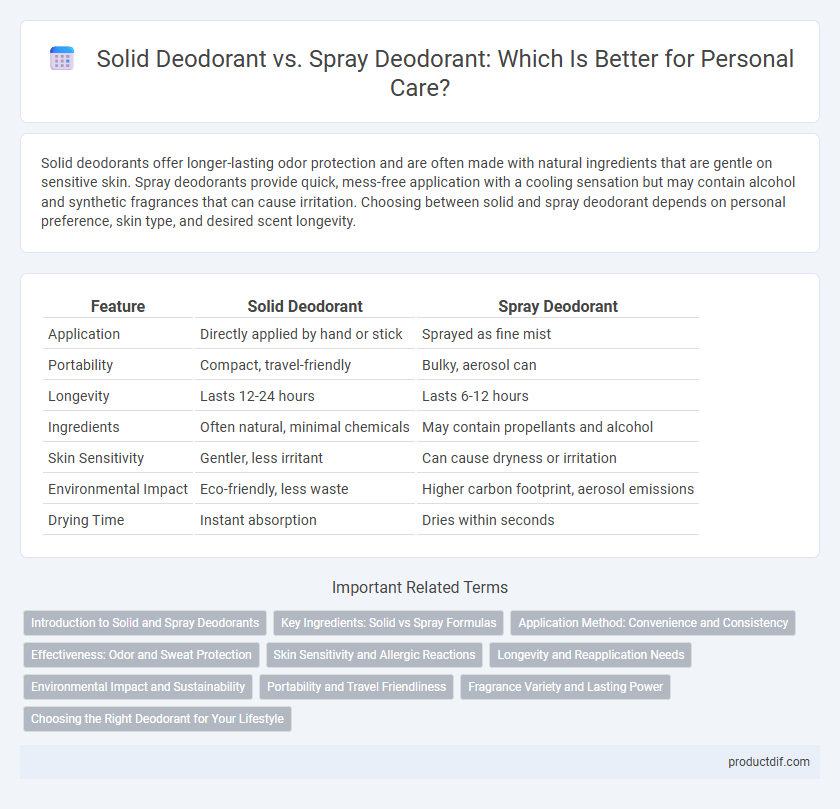Solid deodorants offer longer-lasting odor protection and are often made with natural ingredients that are gentle on sensitive skin. Spray deodorants provide quick, mess-free application with a cooling sensation but may contain alcohol and synthetic fragrances that can cause irritation. Choosing between solid and spray deodorant depends on personal preference, skin type, and desired scent longevity.
Table of Comparison
| Feature | Solid Deodorant | Spray Deodorant |
|---|---|---|
| Application | Directly applied by hand or stick | Sprayed as fine mist |
| Portability | Compact, travel-friendly | Bulky, aerosol can |
| Longevity | Lasts 12-24 hours | Lasts 6-12 hours |
| Ingredients | Often natural, minimal chemicals | May contain propellants and alcohol |
| Skin Sensitivity | Gentler, less irritant | Can cause dryness or irritation |
| Environmental Impact | Eco-friendly, less waste | Higher carbon footprint, aerosol emissions |
| Drying Time | Instant absorption | Dries within seconds |
Introduction to Solid and Spray Deodorants
Solid deodorants offer a compact, mess-free application with ingredients that often include natural oils and waxes for long-lasting odor protection. Spray deodorants provide a quick-drying formula that covers large areas effortlessly, typically containing antimicrobial agents and fragrance compounds. Both types deliver effective odor control but cater to different preferences in texture, application method, and scent intensity.
Key Ingredients: Solid vs Spray Formulas
Solid deodorants typically contain natural ingredients like baking soda, shea butter, and coconut oil, which provide long-lasting odor protection and skin moisturization. Spray deodorants often feature alcohol, aluminum compounds, and synthetic fragrances that offer quick-drying application and effective anti-perspirant benefits. The choice between solid and spray formulas depends on preferences for ingredient transparency, skin sensitivity, and desired application method.
Application Method: Convenience and Consistency
Solid deodorants offer precise application, minimizing product wastage and allowing for consistent coverage, while their compact form makes them highly portable for on-the-go use. Spray deodorants provide quick, even application over larger areas, but may result in uneven distribution and slower drying times, impacting convenience during busy routines. Choosing between them depends on personal preference for tactile control versus speed and ease of use.
Effectiveness: Odor and Sweat Protection
Solid deodorants provide long-lasting odor protection by creating a barrier that absorbs sweat and neutralizes bacteria, making them highly effective for extended wear. Spray deodorants offer quick-dry formulas that evenly cover large areas, providing immediate freshness and sweat control, especially useful during high-activity periods. Both types contain active ingredients like aluminum compounds or natural extracts that target odor-causing bacteria and regulate perspiration, but solid deodorants often excel in sustained sweat absorption.
Skin Sensitivity and Allergic Reactions
Solid deodorants typically contain fewer irritants and preservatives, making them more suitable for sensitive skin and reducing the risk of allergic reactions. Spray deodorants often include alcohol and synthetic fragrances that can cause dryness, irritation, or contact dermatitis in sensitive individuals. Choosing a solid deodorant with natural ingredients like shea butter or aloe vera can help minimize skin sensitivity and prevent allergic responses.
Longevity and Reapplication Needs
Solid deodorants typically offer longer-lasting protection due to their concentrated formula that adheres well to the skin, reducing the need for frequent reapplication. Spray deodorants provide a quick, even application but often evaporate faster, necessitating more frequent touch-ups throughout the day. Consumers seeking extended odor control commonly prefer solid deodorants for their superior longevity.
Environmental Impact and Sustainability
Solid deodorants generate significantly less plastic waste compared to spray deodorants, as they often come in minimal or recyclable packaging. Spray deodorants release volatile organic compounds (VOCs) into the atmosphere, contributing to air pollution and ozone layer depletion. Choosing solid deodorants supports sustainable practices by reducing chemical emissions and limiting non-biodegradable waste.
Portability and Travel Friendliness
Solid deodorants offer superior portability due to their compact, leak-proof design, making them ideal for travel without restrictions on liquid carry-ons. Spray deodorants, while convenient for quick application, often come in bulkier aerosol cans that can be subject to airline liquid regulations. Choosing solid deodorants enhances travel friendliness by reducing the risk of spills and meeting TSA compliance effortlessly.
Fragrance Variety and Lasting Power
Solid deodorants offer a wide range of natural and subtle fragrances that cater to sensitive skin, while spray deodorants often feature bolder, longer-lasting scents with fast-drying formulas. The lasting power of spray deodorants typically surpasses solid deodorants, providing prolonged odor protection for active lifestyles. Consumers seeking gentle, skin-friendly options may prefer solid deodorants, whereas those prioritizing intense fragrance and extended wear often choose sprays.
Choosing the Right Deodorant for Your Lifestyle
Solid deodorants offer long-lasting protection and are ideal for individuals seeking a natural, aluminum-free option that reduces skin irritation. Spray deodorants provide quick application and are convenient for on-the-go use, featuring fast-drying formulas that help control odor and sweat effectively. Selecting between solid and spray deodorants depends on your daily routine, skin sensitivity, and preference for natural ingredients or convenience.
Solid deodorant vs Spray deodorant Infographic

 productdif.com
productdif.com